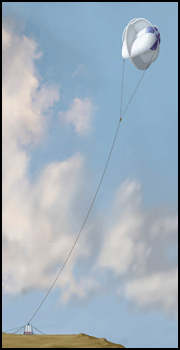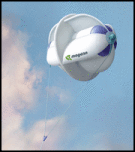 The Best-Breezes blog entry of January 7, 2006 about the Magenn MARS (Magenn Air Rotor System) was so well received by readers that it prompted me to investigate more deeply the relationship that this high tech electrical energy generator has with the simple rotor kite that inspired the concept.
The Best-Breezes blog entry of January 7, 2006 about the Magenn MARS (Magenn Air Rotor System) was so well received by readers that it prompted me to investigate more deeply the relationship that this high tech electrical energy generator has with the simple rotor kite that inspired the concept.
Readers from both the kite community and general visitors seeking information on an innovative source of power generation asked how the concept to use a kite in such a novel manner originated.
I contacted Fred Ferguson of Magenn Power Inc. and asked for an interview to help my readers understand more about the MARS and its relationship to the horizontal rotor kite. Fred, the founder of Magenn, graciously accepted and below you will find his answers to questions posed by Best-Breezes.
__________
Best-Breezes: "What inspired you to use the modified rotor kite concept for your aerial wind power generation system?"
Fred Fergusson of Magenn Power Inc:
"The rotor kite concept was somewhat of a natural evolution from our extensive work on rotating sphere airships in the 1980s. The Magnus Aerospace airship utilized the same aerodynamics as a rotor kite. In 2002 I read an article about using a traditional kite or glider system to generate electricity. This inspired me to look back at the magnus airship work whereby the sphere could free wheel in the wind with rotor kite like blades. This evolved to the design we have today. "
Best-Breezes: "What are the advantages of your Magenn Air Rotor System (MARS) over traditional, stationary wind turbines?"
Fred Ferguson:
"The Magenn rotor is an inflatable structure that, like a blimp, can be built in very large sizes at relatively low cost. The main advantage of the Magenn rotors is their Power output (power coefficient) vs capital cost when compared to equivalent output wind turbines. Other features such as mobility, no tower required, low operating speed, ability to get up into higher winds and better wind speed latitude are also competitive factors."
Best-Breezes: "Kite fliers would be interested to know how much research you did on "horizontal rotor kites" as a part of your concept development?"
Fred Ferguson:
"Most of our research relates to the magnus effect. In the 1980s we conducted over 160 wind tunnel tests to fully understand the properties of this unusual aerodynamic effect. My first rotor kite was purchased about 1984, it was similar to the traditional shape two end disk versions we see today. This helped proved certain aspect that we had discovered in the wind tunnel tests. Today we have a very large library and understanding of the magnus effect."
Best- Breezes: "Which sources of information on rotor kites were of most use to your team?"
Fred Ferguson:
"Today the best information comes from the internet. The most recent kite purchase was a UFO silver mylar rotor kite with the single center disk. In the past I have found sites such as Anthony's Kite workshop (anthony@cit.gu.edu.au ) , or Philip Le Riche's Virtual Kite Zoo to be helpful sources."
Best-Breezes: "Did you acuire, build or fly any rotor kite models as part of the development of your Magenn Air Rotor System (MARS)? If so, what did you learn from these that helped you with your concept design?"
Fred Ferguson:
"The rotor kites are very useful to demonstrate the magnus effect. The kites provided the necessary proof when designing the Magenn rotor as a cylindrical type device. The rotor kites also demonstrate enhanced stability, drag vs lean, and of course lifting effect. All components of the magnus aerodynamic effect."
Best- Breezes: "What part does the 'rotor kite' design play in keeping your MARS stable and directed into the wind?"
Fred Fergusson:
"As mentioned above just about every feature of a rotor kite applies to the Magenn rotor, enhanced stability, side or center stabilizer design, yoke cable, single tether, axial spin, etc. The mangus effect lift is an active component it's just that this lift is diminished by slowing the rotor speed due to the generator power load."
Best-Breezes:
"Have you developed any prototype models of a small size to date? If so, how do they seem to 'fly' in test conditions?"
Fred Ferguson:
Other than flying versions of rotor kites, and the past magnus airship program (which included flying prototypes) all of our current work has focused on test bed and wind tunnel modeling. We expect to see the first large flying prototype this coming summer (2006).
Best-Breezes:
"Do you have any plans to develop mini versions of your MARS, without the electrical generation capacity, to sell to interested kite fliers? Knowing that many kiters are seeking novel kites for flight when they go to kite festivals, this could be a marvelous, low cost publicity option."
Fred Ferguson: "That is an excellent idea . . . "
Best- Breezes: "Thank you Fred for taking the time to answer questions that are of interest to kite flyers. Certainly your innovative and cutting edge work applying kite technology to generate renewable energy is innovative and interesting. I know that all kite fliers wish you well with your project and we will be following your story closely. Perhaps some day you will grace us at a kite festival with a demonstration model. I know that kite enthusiasts everywhere will be attracted by your marvelous device!"
__________
 Since our original posting about the Magenn Power Air Rotor, the company has entered into an agreement with the Krystal Planet Corporation of Kansas City to distribute the MARS airborne tethered wind generators in the summer of 2006. All of this is exciting news for the clean, renewable energy market. Congratulations to both Magenn Power Inc., of Kanata, Ontario, and the Krystal Planet Corporation of Lenexa, Kansas, U.S.A.
Since our original posting about the Magenn Power Air Rotor, the company has entered into an agreement with the Krystal Planet Corporation of Kansas City to distribute the MARS airborne tethered wind generators in the summer of 2006. All of this is exciting news for the clean, renewable energy market. Congratulations to both Magenn Power Inc., of Kanata, Ontario, and the Krystal Planet Corporation of Lenexa, Kansas, U.S.A.
Acknowledgements
Sincere appreciation is extended to Fred Ferguson of Magenn Power Inc. for taking the time to correspond with Bes-Breezes on a number of occasions. His thoughtful answers to questions of interest to kite fliers will be appreciated by readers of this site and journal. It is our hope that we will be able to meet Fred at a kite festival very soon. We look forward to seeing a demonstration model of his innovative kite rotor which will be a source of renewable energy.
Images of the MARS are courtesy of the Magenn Power Inc. web site.